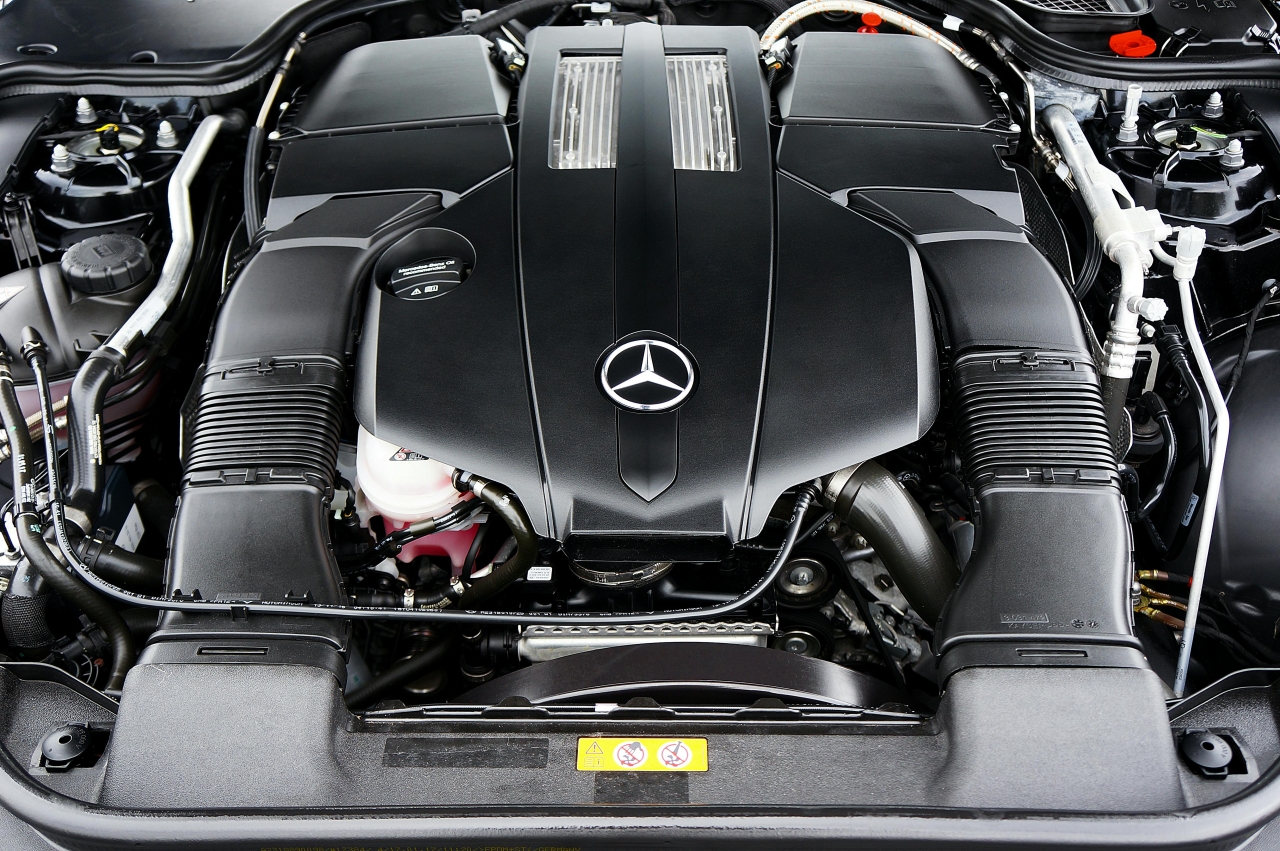The OM642 engine is a proven 3.0 V6 CDI engine that has found its way into numerous Mercedes models – from sedans to SUVs and vans. Smooth operation, solid torque, and flexibility make these cars excellent for everyday use to this day. Over time, however, injection precision and turbine condition determine noticeable dynamics and fuel consumption. The good news: replacing the injectors and refreshing the turbocharger restores the OM642's real power and smoothness, without any changes to the system. The following guide summarizes the engine's specifications, models, typical symptoms, and a practical action plan – all in the spirit of reasonable costs and factory fit.
Context OM642
What defines the 3.0 V6 CDI
This Mercedes V6 engine ( Mercedes-Benz engine, codenamed OM642) debuted in 2005 and quickly became the foundation of the diesel range. It has an aluminum block, DOHC, and four valves per cylinder, and the common rail system is supplied by CP3 and later CP4 pumps. Standard configurations utilize turbocharging—usually a single variable geometry compressor, which provides consistent thrust from low revs. The result is high operating refinement and strong torque, especially in the 1,400–2,800 rpm range, where the V6 CDI tends to ride the wave without unnecessary downshifts. The Mercedes V6 3.0 CDI engine, or the Mercedes OM642, appears as, among others: the Mercedes E-Class 3.0 CDI engine, the Mercedes S-Class 3.0 CDI engine, the Mercedes ML/GL 3.0 CDI engine, the Mercedes G-Class 3.0 CDI engine, the Mercedes CLS 3.0 CDI engine, and in vans – the Mercedes Sprinter 3.0 CDI engine. Regardless of the body style, the principle is the same: sort out the injection and turbocharging, and the engine will regain consistent operation. Thanks to the wide availability of genuine aftermarket parts, used car parts and original parts for the OM642 can be selected for a specific variant code.
OM642 Models and Applications
The OM642 engine is found in many Mercedes bodies: E-Class (W211/W212), S-Class (W221), CLS (C219/C218), ML/GLE (W164/W166), GL (X164), G-Class (W463), R-Class (W251), as well as in the Sprinter vans (906) . Power and torque variants depended on the year and market – from calm configurations in limousines to more "utility" calibrations in the Sprinter. Thanks to the modularity of the equipment, the Mercedes V6 engine also found its way into the 4MATIC version ( Mercedes A 45 AMG 4MATIC ), where it works harmoniously with the automatic transmission and four-wheel drive. This makes the market for aftermarket parts and used car parts for the OM642 broad and predictable in terms of fit.
Key technical facts
The OM642 is a 3.0-liter V6 diesel engine with a 72-degree cylinder bank angle. The aluminum block reduces weight, and DOHC cylinder heads improve mid- and upper-range breathing. Common Rail (CP3/CP4) allows for precise fuel delivery at high pressures, resulting in quiet operation and responsiveness. A variable geometry turbocharger dynamically adjusts exhaust flow and thus the engine's response to gas. In many versions, power was combined with stringent emissions standards, so proper oil selection (e.g., MB 229.51-compliant grades) and proper DPF maintenance are crucial.
Why injection and turbochargers restore performance
Injection precision and boost efficiency determine the Mercedes OM642's power delivery in real-world driving. Piezoelectric injectors can meter fuel with pinpoint precision, but over time, needle and nozzle wear affects the fuel delivery and atomization. The engine begins to smoke, loses its driveability, and increases fuel consumption. On the other hand, a variable geometry turbocharger, if it's carbon-laden or has worn bearings, doesn't kick in as quickly and produces lower mid-range boost. After replacing the injectors with matched parts and renewing the compressor (or installing a used OEM unit in good condition), the OM642 regains smooth acceleration, runs more quietly, and significantly reduces fuel consumption in the combined cycle.
When to think about injectors and turbine
If a slight "wobble" in the injection quantity occurs at a constant speed, or the injection corrections are clearly worn out, this is a sign that the injectors are nearing their end of life. Other symptoms include rough acceleration under load and higher fuel consumption during a leisurely drive. On the turbo side, typical symptoms include sluggish low-end response, a whistling sound that varies with rpm, or boost pressure errors. In extreme cases, cracks in the exhaust manifold can "feed" the turbine with debris, so if you suspect a leak in the exhaust system, it's worth reacting quickly to protect the compressor.

The role of timing and DPF
At very high mileage (around several hundred thousand kilometers), the timing chain can stretch, resulting in a rattle on start-up and timing corrections. This is a good time to inspect the timing chain drive – some users combine these tasks when planning injectors and turbochargers. In cars with a DPF filter, the right oils and routing are crucial, allowing for the soot to be burned off smoothly. When the injector and turbocharger return to normal, the amount of unburned fuel entering the DPF decreases, increasing regeneration efficiency and reducing the filter warning light's frequency.
Refresh Strategies: Three Paths, One Effect
The "injection" route: in cars with a healthy turbo, simply replacing the injectors can restore smooth operation and quiet operation at a constant speed. The "turbo" route: in cars with correct tuning but sluggish bottom end, refreshing the compressor and controlling the intake airflow are often sufficient. The "combo" route: combining injection and turbine, and at high mileage – a look at the chain, guides, and sliders. Each of these routes pays off with improved flexibility and lower fuel consumption, which can translate into a noticeable fuel cost over the course of a year.
Installation and service: when to go to the workshop
Work on the injection system and turbocharger requires cleanliness, torque, and calibration. After installation, the injectors should be coded into the ECU, and on the turbine side, it's worth confirming boost pressure and intake tightness. An inspection of the intercooler is also recommended – the oil film is normal, but oil puddles suggest excessive blow-by on the compressor side or a blow-off valve. If the car has an automatic transmission and 4MATIC, it's also a good idea to inspect the drive mounts and the condition of the VNT vacuum control lines.
Used and Reconditioned: A Smart Choice on a Budget
Piezo injectors in this engine are often replaced with "off-the-shelf" references, as their regeneration can be difficult or economically unattractive. Here, the natural solution is to use used OEM parts from a reliable source – a plug-in, compatible indexes, and a quick coding procedure. With turbochargers, it makes sense to remanufacture the core (CHRA) as well as install a complete original compressor from a disassembly. The advantage of this approach is speed: original mounts and less time on the hoist, which reduces the overall cost of the operation. This is why workshops are eager to combine aftermarket parts with manufacturer service procedures.
Parameters and numbers: it is really improving
Once injection precision and turbine efficiency are restored, average boost increases in the everyday RPM range, and fuel injection adjustments stabilize around reference values. In practice, drivers experience more linear acceleration from 1500 RPM, quieter idle, and noticeably lower fuel consumption during steady driving. The scale of the effect depends on the condition of the system and ECU calibration, but in cars primarily used for city driving and highway driving, the improvement is noticeable within the first week.
Mistakes and Pitfalls: What to Avoid with OM642
The most common problems stem from mixing references without verifying the indexes and omitting injector coding. Loose connections in the intake manifold or incorrectly installed clamps are equally common – these are when the turbo performs worse than it should, even though everything "on paper" is new. It's also common to interpret every whistle as a "damaged turbo" when the source is a leak at the connector or a cracked manifold. Common sense and a service procedure protect your wallet better than "shots in the dark."

Listings in the content: technical parameters OM642
| Parameter | Value / Description |
|---|---|
| Designation | OM642 (Mercedes Benz engine 3.0 V6 CDI) |
| Cylinder arrangement | V6, angle 72° |
| Block / heads | Aluminum / DOHC, 4 valves/cyl. |
| Injection | Common Rail (CP3 → CP4) |
| Top-up | Variable geometry turbine (VNT) |
| Character | High work culture, big momentum |
| Oils / Emissions | MB 229.51 and related, DPF care |
OM642 models – selection by VIN
| Model | Engine variant | Matching Notes |
|---|---|---|
| E-Class (W211/W212) | Mercedes 3.0 CDI engine (OM642) | Injectors/turbo by VIN; year differences |
| S-Class (W221) | Mercedes V6 3.0 CDI engine | Power variants; injection coding |
| CLS (C219/C218) | OM642 3.0 V6 CDI | Family intake/turbo assembly |
| ML/GLE (W164/W166) | 3.0 V6 CDI | VNT check, intake tightness |
| GL (X164), G (W463) | OM642 (4MATIC) | Consistency with 4x4 layout and cooling |
| R-Class (W251) | 3.0 CDI | Injection indexes compatible with ECU |
| Sprinter (906) | 3.0 V6 CDI | Priority: Turbo operating conditions |
Symptoms – Cause – Action: Mercedes
| Symptom | Possible cause | Recommended action |
|---|---|---|
| Dose fluctuation, smoking | Worn piezo injectors | Replacement with compatible OEM, coding |
| Sluggish bottom, whistling with turns | Turbo bearings / VNT carbon deposits | CHRA regeneration or turbine replacement |
| Higher fuel consumption on the road | Imprecise atomization | Injectors + injection map control |
| Rattle on start-up | Extended chain | Drive inspection, complete replacement |
| DPF warning lights | Cigarette butts, short trips | Injection/turbo cleaning, MB 229.51 oil |
| Loss of charge | Leaking intake/manifold | Leak test, new clamps/seals |
FAQ: Frequently asked questions by drivers
| Question (FAQ) | Short answer |
|---|---|
| What is VIN and why provide it with OM642? | The VIN allows you to select injectors, turbine and accessories for the version and year. |
| Can piezo injectors be regenerated? | Most often, a complete, OEM-compatible one is selected and coded in the ECU. |
| How to know if the turbine is not demanding? | Sluggish bottom end, whistling with revs, boost errors; confirmed by logs and leak test. |
| Does improving injection/turbo affect DPF? | Yes – the number of unburned fuels decreases, the DPF regenerates more efficiently. |
| What oils for DPF? | Complies with MB standards (e.g. 229.51) to reduce ash. |
| When to combine work with timing? | In case of rattle/high mileage – saving time and labor. |
| Which models are the tips compatible with? | E, S, CLS, ML/GLE, GL, G, R and Sprinter 3.0 CDI with OM642. |